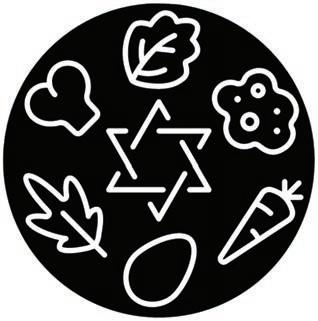
4 minute read
Positively Medieval
PASSOVER
Positively Medieval
Advertisement
This Passover, a Haggadah that’s di erent from all others.
BARBARA LEWIS CONTRIBUTING WRITER
Why is this Haggadah different from all other Haggadot?
Well, it’s the first one Southfield educator and medieval culture buff Marilyn Finkelman has written, illustrated and bound.
And while it’s based on a medieval document, Finkelman’s alterations make it uniquely hers.
Finkelman, 71, of Southfield, and her husband, Rabbi Eliezer Finkelman, have a keen appreciation for all things medieval. For more than 20 years they have been active with the Society for Creative Anachronism, an organization dedicated to researching and recreating the arts and skills of medieval and Renaissance Europe. The Finkelmans specialize in the lifestyle of Jews of that era.
Finkelman has been creating medieval-style Hebrew pieces for many years. When the eldest of her 11 grandchildren celebrated her bat mitzvah, Finkelman’s gift was an illuminated panel with the word baruch — blessed — in Hebrew. Other pieces followed, including a 12-page booklet containing the Hallel prayers for a granddaughter named Hallel and a Hebrew primer for a daughter-in-law’s graduation from library science school. Finkelman also did a collection of psalms for herself.
Now her grandson, Shmuel Pessah Englard, is preparing for his bar mitzvah, and in honor of his middle name and the celebration’s springtime date, Finkelman decided to create a Haggadah for him. At 86 pages, it’s her most ambitious project yet.
She chose as her model the Haggadah portion of the Hamilton Siddur, an illuminated manuscript from the early 1300s owned for many years by Alexander, Earl

ABOVE: Marilyn Finkelman binds the
Haggadah she made for her grandson.
TOP: Pages from the medieval-style
Haggadah she has created.
of Hamilton. The original is now in the Berlin State Library.
Finkelman said she liked the illuminations, which are almost entirely initial letters turned into zoomorphic (animal-like) or anthropomorphic (human-like) forms. She also gained inspiration from a manuscript from the Palatina Library of Parma.
Finkelman made several changes. She added in portions of the modern Haggadah that are missing from the Hamilton version. Before the invention of printing, written text was enormously expensive to produce, and creators of Hebrew manuscripts often omitted passages that the reader would probably have known by heart or had available in other books. For example, the Grace After Meals appears only by reference in most medieval Haggadot. Most also instruct readers to recite various blessings, such as those for matzah and bitter herbs, without writing them out word-for-word.
MODERN ELEMENTS
Finkelman consulted modern Haggadot, including the Maxwell House Haggadah, before deciding on the final wording. She also found some scribal errors in the original and corrected them.
“In general, I stuck with the original where the meaning was the same and went with the modern version where there was a difference in meaning,” she said.
Most Haggadot, both medieval and modern, end with collections of piyutim, religious poetry. Finkelman chose to include the modern set rather than the medieval ones that are unfamiliar to modern readers.
Finkelman’s Haggadah measures 7.5 x 5 inches. She wrote with a reed pen and oak gall ink. Her paint was mixed from pigment, water and gum arabic.
“As I began painting the illuminations, I was surprised to discover they were not as vivid as I expected, “she said. “Therefore I included more of the most vivid colors in the palette and I added decorative whitework throughout.”
Using parchment like the original manuscript did would have been prohibitively expensive, however, so Finkelman used Pergamenata, a vegetable imitation that looks and behaves like parchment.
The book is covered with vegetable-tanned goatskin and cotton paper that she and her husband made last year. It is bound using traditional cord-binding techniques.
The illustrations in medieval manuscripts are “more fun” than those in modern Haggadot, said Finkelman. “The art is telling you, ‘Look at me!’” She thinks her grandson, Shmuel Pessah, will appreciate them because he has a good sense of humor.
One illustration in the Hamilton manuscript stood out: a miniature of three women under an arch. The largest figure is sitting at a desk holding a pen. In the middle a woman holds a ladle in a bowl or pot. The smallest woman is spinning yarn with a drop spindle. Finkelman wonders if the women represent the artist or perhaps the woman who commissioned the work.
Finkelman made high-quality scans of the pages before binding them. Perhaps when the project is completed, she’ll look into making printed copies.

A Seder with Adat Shalom Synagogue
Join Rabbi Aaron Bergman, Hazzan Daniel Gross, and Michael Wolf for an online 2nd night Seder experience Sunday, March 28 at 6:30 pm
concluding at the dinner break
Zoom link: https://us02web.zoom.us/j/83816523450 Meeting ID: 838 1652 3450 / Dial in: 1-646-558-8656 Passcode: Seder
We will provide a Haggadah on Zoom for the Seder







